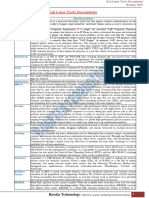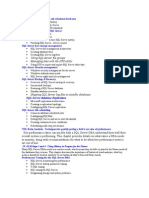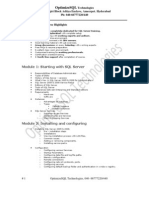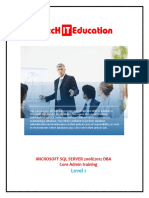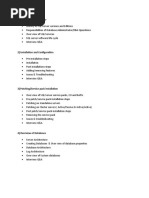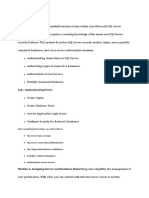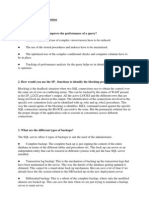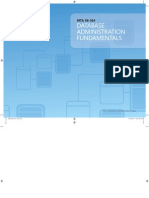0 ratings0% found this document useful (0 votes)
50 viewsSQL Server DBA Course Content
The document outlines the content of a 5-week SQL Server DBA course. The course covers topics such as SQL Server architecture, installation, database design, queries, indexes, stored procedures, locks, security, backups, replication, log shipping, database mirroring, auditing and more. It is divided into 18 chapters across two modules, with Module I focusing on basics and Module II on advanced DBA skills.
Uploaded by
rajiv_ndpt8394Copyright
© © All Rights Reserved
Available Formats
Download as PDF, TXT or read online on Scribd
0 ratings0% found this document useful (0 votes)
50 viewsSQL Server DBA Course Content
The document outlines the content of a 5-week SQL Server DBA course. The course covers topics such as SQL Server architecture, installation, database design, queries, indexes, stored procedures, locks, security, backups, replication, log shipping, database mirroring, auditing and more. It is divided into 18 chapters across two modules, with Module I focusing on basics and Module II on advanced DBA skills.
Uploaded by
rajiv_ndpt8394Copyright
© © All Rights Reserved
Available Formats
Download as PDF, TXT or read online on Scribd
You are on page 1/ 13
SQL Server DBA Course Content
Duration:-5 weeks (Mon –Sat)
Schedule: - 9:30 to 10:30AM IST
Module I: - MSSQL Server & T-SQL Basics (10-days)
Chapter 1: SQL Server 2012 Architecture
SQL Server Evolution
1) Role of a DBA
a) Production DBA
b) Development DBA
c) Hybrid DBA
d) Business Intelligence DBA
2) SQL Server Architecture
a) SQL Components
b) Database and Data files
c) Data storage
d) Memory Management
e) SQL Server Data Types
3) Editions of SQL Server
a) Editions
b) Operating Systems
c) Database Features by Edition
d) Server and DB Licensing
Chapter 2: SQL Server 2012 installation
1) Pre installation Steps
a) hardware choice
b) software and installation Choices
2) Installing SQL Server
a) SQL Server 2012 Installation
b) Service Accounts, Purpose and Usage
c) Authentication Modes & Logins
d) Instance Configuration Options
e) Testing Multiple Installations
f) Management Studio (SSMS) Tool Usage
3) Post –installation Steps
a) Configuration Tool
b) SSMS
c) Tempdb
d) Back it up
4) Troubleshooting Installation failures
5) Uninstalling SQL Server(SQL Database Engine, RS and AS)
Chapter 3: Database Design Concepts
a) SQL Server Database Architecture
b) Database Catalog and Storage Options
c) Data Files : Purpose and Storage
d) Filegroups : Purpose and Usage
e) Log files : Purpose and Audits
f) Use of Transaction Log Files
g) Sizing and Placement - Data Files
h) Sizing and Placement - Log Files
i) Locations and Sizing Recommendations
j) Filegrowth and MAXSIZE Options
k) Scripting Database Structures
l) Database ALTERs and Considerations
m) Placement of Files and Filegroups
Chapter 4: Table Design and Queries
a) Tables Design Concepts & Normal Forms
b) Table Creation Process and Options
c) File Groups and Table Design
d) Role of Schemas and Table Design
e) DML, DDL and SELECT Operations
f) Single Row and Multi-Row Inserts
g) Table Aliases, Column Aliases & Usage
h) INSERT & SELECT Variants in T-SQL
i) Data Types and Column Usage
j) Row size Computation & NULLs
k) Basic INSERT, UPDATE, DELETE
l) Multi-Row Inserts and SELECT Statements
m) SELECT Queries with Schema References
n) Basic Data Types & NULL Value Compares
o) Design Limitations & UPDATES
p) Role of Log Files for DML Operations
q) DELETE versus TRUNCATE Statements
Chapter 5: Indexes and Joins
a) Indexes : Need, Types and Usage
b) Index : Architecture & Placement
c) Index Pages : Design and References
d) Query Optimizer and Query Executions
e) Index SCAN and Index SEEK Plans
f) Clustered & Non Clustered Indexes
g) SORT_IN_TEMPDB Options for Indexes
h) FILLFACTOR and PAD_INDEX Options
i) INCLUDED Column Indexes & Types
j) Using Indexes with Table Constraints
k) Unique Indexes and Tuning Options
l) Indexed Views, Query Plans and Tuning
Chapter 7: Stored Procedures and Joins
a) Stored Procedures – Benefits
b) types of Stored Procedures
c) Use of Variables and Parameters
d) Using SPs for SQL Data Validations
e) Using SPs for Data Reporting Operations
f) Using SPs for Joined Data Sets
g) System Stored Procedures and Usage
h) Dynamic SQL Queries & Usage
i) RECOMPILE Options and Advantages
j) Using SPs with Cursors – Querying
k) Procedures with Temporary Tables
Module II: - Basic MSSQL DBA (15-days)
Chapter 8: Lock Issues & Deadlocks
a) Understanding Locks & their Usage
b) SP_WHO2 and SP_LOCK Outputs
c) Lock Types, Lock Hints and Lock Escalations
d) Avoiding WAITS on PAGE and TABLE
e) Isolation Levels - Types and Usage
f) READ COMMITED and SERIALIZABLE
g) READ UNCOMMITED and REAPEATABLE
h) SNAPSHOT & READCOMITTED SNAPSHOT
i) Choosing Isolation Levels For OLTP
j) Statement Locks & Transaction Locks
k) TempDB Issues with Isolation Options
l) Locking Hints to Avoid Blockings
m) A DEADLOCK Scenario and DML Audits
n) Deadlock Detection and Avoidance
Chapter 09: Logins, Users & Roles
a) Understanding Security Architecture
b) SQL Server Security Authentication
c) Server Level Security and Logins
d) Database Level Security Users
e) Schemas and User Mappings - Usage
f) Server Level Roles and Usage
g) Database Level Roles and Usage
h) Testing Security Operations in SQL
i) Simulating SQL Server Security Logins
j) Login Errors and Password Resets
k) GRANT, DENY & REVOKE Permissions
l) Common Security Functions & Queries
m) Scripting Procedures For Securables
Chapter 10: Object Level Security & Proxies
a) A Realtime Security Scenario
b) Object Level Security & Levels
c) Database Level Roles, Securables and Usage
d) Schema Level Security and Ownership
e) DB Certificates and Master Keys
f) Data Level Security and Encryptions
g) Testing Database Encryption Levels
h) Basic Job Level Security & Options
i) SQL Server Credentials & Scripting
j) Proxies - Purpose, Usage and Options
k) Using Server Credentials for Proxies
l) Using Proxies for Job Level Sub Systems
m) DMVs for Server Security Audits
n) DMVs for Database Security Audits
o) Useful Security Audit Queries (DMVs)
Chapter 11: Backups with T-SQL Scripts
a) Backups Concept and Mechanism
b) Backups Usage and Limitations
c) Data Backups - Syntax and Types
d) Log Backup Mechanism and Use
e) CHECKPOINT and TRUNCATE Options
f) Tuning Database Backup Operations
g) File Backups and Filegroup Backups
h) COMPRESSION, CHECKSUM and STATS
i) Partial Backups with Filegroups
j) Remote Backups and Security Options
k) Backup Jobs and SQL Agent Service
l) Scheduling Backups & Strategies
m) MSDB History Tables and Audits
n) Important Queries for Backup Audits
Chapter 12: Backups and Restores
a) Backup Verification Procedures
b) Recovery Paths and FILELIST Options
c) Database Restores & RECOVERY Options
d) File Restores and Filegroup Restores
e) FILELISTONLY and VERIFYONLY Options
f) MOVE and REPLACE Options For Restores
g) PARTIAL and Piecemeal Restores
h) Tail Log Backups and REDO Phase Options
i) Compressed Tail Log Restores and REPLACE
j) Restores for Partial Online Databases
k) Choosing Right Backups for Restores
Chapter 13: Backups, Restores and Recovery
a) Backup Mirrors and Restore Options
b) Backup Splits and Restore Options
c) Media Set, Media Family and Options
d) FORMAT, NOFORMAT, INIT and NOINIT
e) SQL 2008R2 Backups to SQL 2012 Restores
f) Partial Backups and STATS Options
g) CHECKSUM and CONTINUE_ON_ERROR
h) Compatibility, Recovery Model Options
i) Working with Recovery Models & Backups
j) Backups using UI and SSMS Tool
k) COPY_ONLY Backups and Importance
l) Point-In-Time Restores & Recovery
m) Overwrite Options for DB Restores
n) Backup Devices Creation & Usage
o) Backup Devices Uses and Limitations
Chapter 14: Replication For HA/DR
a) Replication Use & Importance
b) Replication Architecture & Entities
c) Articles, Publications, Subscriptions
d) Deciding Distribution Components
e) Distributor & Snapshot Paths
f) Distribution DB Configurations
g) Articles, Filters and Publications
h) Article Dependencies & Encryption
i) Working of Snapshot Replication
j) Working of Transactional Replication
k) PUSH and PULL Subscription Options
l) Replication Monitor - Usage & Options
m) Testing Replication Components
n) Replication Jobs and Verification
Chapter 15: Replication Tuning & Issues
a) Working of Merge Replication & Agents
b) Replication Conflicts and ROWGUIDCOL
c) Tuning Merge Agent and Security
d) Domain Accounts For Replication
e) Limitations with Merge Replication
f) Peer-Peer Replication with Pull Distributors
g) Peer-Peer Replication and Conflicts
h) Adding New Peer Nodes in P2P Replication
i) Replication Initialization with Backups
j) Replication Errors, Conflicts and Solutions
k) Replication Event Watchers and Data Audits
l) Article and Filter Management Options
m) Replication for HA & DR Procedures
Chapter 16: Log Shipping for DR
a) Log Shipping Architecture and Jobs
b) Choosing Primary, Standby Servers
c) Log Shipping Monitor Configuration
d) NORECOVERY Configuration and Usage
e) STANDBY Mode Configuration and Usage
f) Log Shipping Jobs and Schedules
g) Backup Jobs and Possible Failures
h) Copy & Restore Jobs with Secondary
i) Log Shipping Monitor and Status Reports
j) Manual Fail-over Process - Options
k) Log Shipping Topology - Limitations
l) Versioning Issues and Data Traffic
m) Log Shipping for DR Procedures
Chapter 17: DB Mirroring for Disaster Recovery
a) DB Mirroring Architecture & Use
b) Mirroring Configuration Scenarios
c) Backups & Restores for Mirrors
d) TCP Endpoints & Network Security
e) Heartbeat and Polling Concepts in DM
f) Working with Service Accounts & Use
g) Automatic Fail-Over Procedures
h) Manual Fail-over Options & Scenarios
i) PARTNER OFFLINE Conditions & Options
j) DB Mirror Monitors and Commit Loads
k) Real-World Considerations & DR Options
l) DR & HA with DB Mirroring Advantages
Chapter 18: Database Audits and Queries
a) Query Resources - CPU, IO and Memory
b) Audits - Activity Monitor Usage
c) Audits - SQL Server Profiler Tool Usage
d) Database Health Check & DBCC
e) Log Space Usage Audits with DMVs/DMFs
f) Tempdb Usage Audits with DMVs/DMFs
g) Memory Usage and Disk Usage Audits
h) Considerations Using SQL Profiler
i) Locking Templates and Deadlock XDL Files
j) Deadlock Graphs with SQL Profiler
k) Audit Long Running Queries with DMV/DMF
l) Audit Frequent Running Queries
m) Query Audits and DMVs / DMFs, Joins
n) Audits for Storage Allocation Issues
Chapter 19: Data Exports (SSIS) and DB Mail
a) Import & Export Operations
b) OLE-DB, SQLNCLI and Jet Drivers
c) Choosing correct Data Providers
d) Scheduling SSIS Packages using Jobs
e) Proxies and Reading Job History
f) Database Scripting and DB Encryption
g) Database Cloning Process and Options
h) Configuring Linked Servers - Custom
i) SQL Server Agent - Alert Properties
j) Database (DB) Mail Configurations
k) Securing DB Profiles : SMTP Accounts
l) DB Mail Profiles and Public Tokens
m) Alert System Configurations in SQL Agent
n) Creating Operators and Emails
o) Warnings and Emails with DB Mail
p) Testing Job Failures and Notifications
q) Job Activity Monitor and History Deletes
Module III – Advanced SQL DBA (15-days)
Chapter 20: Understanding Real-time Scenario
a) An Online Book Sales Project
b) DBA Challenges in Real-time
c) SLA and OLA Process in Real-time
d) Need for Documentations & References
e) Downtime & Maintenance Notifications
f) Using SQL Browser Service for TCP/IP
g) Configuration Manager Tool - Usage
h) SQL Server Log-On Accounts and Usage
i) Resource Governor & Performance
j) Workload Groups and Tuning Policies
k) RECONFIGURE Options and Performance
l) Routine DBA Activities - Checklist
m) Database Maintenance Activities
Chapter 21: Partitions & Query Tuning
a) Big Data - Performance Considerations
b) Table Partitions and Tuning Options
c) Partition Functions and Usage
d) Partition Schemes and Reusability
e) Deciding Partition Ranges & Functions
f) Partitioned Data For Complex Queries
g) Partitioning Un-partitioned Structures
h) Aligned Partitions and Performance
i) Fill Factor Options and Index Tuning
j) Partitions for Query Tuning Operations
k) Statistics with Table & Index Partitions
l) Data Compression Types and Options
m) Managing Partitions and Tuning Options
n) Statistics Role in Query Tuning Process
Chapter 22: Full Text Indexes & Tuning
a) LIKE Operator - Limitations & Wild-cards
b) Full Text Search Configuration
c) Full Text Search Service and Options
d) Database Catalogs (FTC) and Storage
e) Full Text Indexes for Tuning Options
f) Full Text Columns and Primary Index
g) Full Text Index and Searching Queries
h) CONTAINS() and FREETEXT() Functions
i) Manual Data Populations and Index Loads
j) CHANGE_TRACKING options & Limitations
k) Securing FT Catalogs and FT Indexes
l) Performance Advantages with FT Indexes
Chapter 23: Index Management & Tuning
a) Index Internals and Execution Plans
b) Index Fragmentation - Issues & Solutions
c) SAMPLED & DETAILED Query Scans
d) Index Rebuilds & Tuning Options
e) Table Rebuild Options with Indexes
f) Index Reorganization Process and Uses
g) Page and Row Compressions with Indexes
h) FILLFACTOR and PADINDEX Index Options
i) Filtered Indexes, Online Indexes, Views
j) Understanding Workload Files in Profiler
k) Understanding Workload Tables in Profiler
l) understanding Tuning and Lock Templates
m) Index Selectivity Options and Statistics
n) Database Tuning Advisor (DTA) - Usage
o) Understanding PDS Options with Indexes
p) Choosing Correct Option (PDS) for Tuning
q) Filtered Indexes and Sizing Options
r) Analyzing Work Load Tables and Scans
s) Statistics Role in Query Tuning Process
t) Understanding Statistics and Query Tuning
Chapter 24: Database Maintenance Plans
a) Database Maintenance Plans (SSIS)
b) DB Maintenance Strategies & Schedules
c) MSDB History Management Options
d) Backup Files and Space Management
e) Reorganizing Indexes with DB Maint. Plans
f) Modifying SSIS DB Maintenance Plans
g) Scheduling and Maintaining SSIS Plans
h) Log File Issues and Shrinking Operations
i) SQL DB Engine Properties & Guidelines
j) Service Configuration Properties
k) Distributed Transactions & Connections
l) Query Governor Usage and DOP Options
m) Policy Based Management (PBM) & Facets
n) Database Properties & Conditions
o) Scheduling Policies & Event Management
p) Considerations for Policy Management
q) Query Facet Conditions for Scheduled Policies
Chapter 25: Alerts, Issues & Troubleshooting
a) LOG File Space Issues and Solutions
b) TEMPDB Space Issues with Solutions
c) MEMORY Management Issues - Solutions
d) OS Level Memory Clerks and Monitoring
e) Memory Leaks, Hits and Solutions
f) Logical and Physical Memory Architecture
g) Procedure Cache Issues and Solutions
h) DB State Events, Issues and Solutions
i) Network Usage, Monitoring & Optimization
j) Performance Monitor (PERFMON) Counters
k) Replication Threshold Values & Agents
l) Database Options and Downtime
m) Database States Alerts and DB Events
n) DBCC Commands and Database Repairs
o) Rebuild Operations and Considerations
p) Important DMVs and DMFs for Audits
Chapter 26: SP & Server Upgrades
a) Establishing Downtime For Maintenance
b) Precautions for Maintenance Activities
c) Service Packs and Patch/hotfix Activities
d) Verifications, SmokeTest and Rollbacks
e) Upgrade Advisor Tool - Analysis Reports
f) Upgrade Advisor Issues and Warnings
g) Server Upgrades and Precautions
h) Planning for Maintenance Activities
i) Rebuilding System Databases & Objects
j) Pre Database Maintenance Activities
k) Post Database Maintenance Activities
l) Real-world Management Considerations
Chapter 27: Introduction to SQL Clusters
a) Understanding SQL Clustering Need
b) SQL Server Clustering Architecture
c) Understanding Ping Tests and Heartbeat
d) Windows and SQL Server Licensing
e) Windows Server Installation Options
f) SP Installation and Quorum Options
g) Installing Windows MSCS Service
h) Verifying SQL Cluster Installation
i) SQL Server Cluster PING and RAID Tests
j) Verifying Cluster Configurations
k) Software RAID Configuration and Issues
Chapter 28: Active Directory and DTC
a) Need for Centralized Authentication
b) Domain Controller (DC) Configuration
c) Active Directory Settings and Usage
d) DCPROMO Settings for Active Directory
e) Working with Active Directory (AD) Edits
f) Network Configurations and Usage
g) PING Configurations and DTC Options
h) QUORUM settings and SAN Options
Chapter 29: SQL Cluster Configuration
a) SQL Server Cluster Installation (VM)
b) Add Nodes to SQL Server Cluster
c) SQL Group and AD Syncup Operations
d) SAN System for Shared Data Storage
e) MS DTC Configurations (Local/Remote)
f) Smoke Test Procedures in Real-time
g) Fail-Over Disk & RAID Implementation
Chapter 30: HA / DR in Clusters and AAG Solutions
a) Connection Issues and Drains
b) Security Issues with Solutions
c) Storage Issues with Solutions
d) Installing Updates in SQL Clusters
e) QUORUM Checks, Storage Issues
f) SQL Server Cluster Utilities & Usage
g) Always-On Availability Groups (AAG)
h) Practical Challenges For HA and AAG
Chapter 31: SQL Server Cluster Management
a) Real-World Considerations For AAG
b) SQL Server Cluster and AAG Limitations
c) SQL Clusters For High Availability
d) Active-Active Cluster Configurations
e) Active-Passive Cluster Configurations
f) Cluster Working and Operative Modes
g) Configuration Settings - Monitors
h) SQL Server Cluster Node Updates
i) Cluster Configurations and Planning
j) AAG Issues and Real-world Challenges
You might also like
- Dangerous Google - Searching For Secrets PDF88% (26)Dangerous Google - Searching For Secrets PDF12 pages
- Murach's SQL Server 2019 For Developers Isbn139781943872572100% (2)Murach's SQL Server 2019 For Developers Isbn139781943872572700 pages
- Murachs SQL Server 2016 For Developers - Searchable PDF70% (10)Murachs SQL Server 2016 For Developers - Searchable PDF696 pages
- Download ebooks file The Volatility Edge in Options Trading New Technical Strategies for Investing in Unstable Markets 1st Edition Jeff Augen all chaptersNo ratings yetDownload ebooks file The Volatility Edge in Options Trading New Technical Strategies for Investing in Unstable Markets 1st Edition Jeff Augen all chapters55 pages
- David Amos, Dan Bader, Joanna Jablonski, Fletcher Heisler Python100% (15)David Amos, Dan Bader, Joanna Jablonski, Fletcher Heisler Python643 pages
- Understanding Database Types - by Alex XuNo ratings yetUnderstanding Database Types - by Alex Xu13 pages
- Policy Document Ucc Redemption Understanding The Process Further80% (20)Policy Document Ucc Redemption Understanding The Process Further37 pages
- Course 20462C: Administering Microsoft SQL Server DatabasesNo ratings yetCourse 20462C: Administering Microsoft SQL Server Databases7 pages
- Google Cloud Platform for Data Engineering: From Beginner to Data Engineer using Google Cloud PlatformFrom EverandGoogle Cloud Platform for Data Engineering: From Beginner to Data Engineer using Google Cloud Platform5/5 (1)
- Dark Web Market Price Index Hacking Tools July 2018 Top10VPN291% (11)Dark Web Market Price Index Hacking Tools July 2018 Top10VPN27 pages
- Allison, Berkowitz - 2008 - SQL For Microsoft Access PDF100% (1)Allison, Berkowitz - 2008 - SQL For Microsoft Access PDF393 pages
- Microsoft SQL Server Database AdministrationNo ratings yetMicrosoft SQL Server Database Administration6 pages
- Professional SQL Server 2012 Dba Online Training @MindQNo ratings yetProfessional SQL Server 2012 Dba Online Training @MindQ6 pages
- Microsoft SQL Server 2008 AdministrationNo ratings yetMicrosoft SQL Server 2008 Administration122 pages
- Microsoft SQL Server Administration Using MS SQL Server 2008No ratings yetMicrosoft SQL Server Administration Using MS SQL Server 2008122 pages
- Murach's SQL Server 2012 For Developers: Who This Book Is ForNo ratings yetMurach's SQL Server 2012 For Developers: Who This Book Is For2 pages
- SQL Server 2012 Database Administration With Alwayson & Clustering TechniquesNo ratings yetSQL Server 2012 Database Administration With Alwayson & Clustering Techniques9 pages
- The History of SQL Server and Relational DatabasesNo ratings yetThe History of SQL Server and Relational Databases5 pages
- Administering Microsoft SQL Server DatabasesNo ratings yetAdministering Microsoft SQL Server Databases4 pages
- 6710cb971a4a7 1729153943 Ms SQL Server SimplifiedNo ratings yet6710cb971a4a7 1729153943 Ms SQL Server Simplified173 pages
- SQL Server DBA Online Training in USA, UK, Canada, AustraliaNo ratings yetSQL Server DBA Online Training in USA, UK, Canada, Australia9 pages
- Topic 1: Starting With SQL Server: Starting With SQL ServerNo ratings yetTopic 1: Starting With SQL Server: Starting With SQL Server5 pages
- (Ebook) Beginning Microsoft SQL Server 2008 Programming by Robert Vieira ISBN 9780470257012, 0470257016instant download100% (3)(Ebook) Beginning Microsoft SQL Server 2008 Programming by Robert Vieira ISBN 9780470257012, 0470257016instant download59 pages
- Administering Microsoft SQL Server 2014 Databases: ID MS-20462 Price On Request Duration 5 DaysNo ratings yetAdministering Microsoft SQL Server 2014 Databases: ID MS-20462 Price On Request Duration 5 Days5 pages
- SQL Server DBA Training with CLoud(AWS and Azure) (1)No ratings yetSQL Server DBA Training with CLoud(AWS and Azure) (1)5 pages
- Addison Wesley The GuruS Guide To SQL Server Architecture and Internals 2003 Ken Henderson PDFNo ratings yetAddison Wesley The GuruS Guide To SQL Server Architecture and Internals 2003 Ken Henderson PDF1,367 pages
- Ms SQL Server 2016 Training DBA 2018 Contents100% (2)Ms SQL Server 2016 Training DBA 2018 Contents16 pages
- Learn Professional Programming in .Net Using C#, Visual Basic, and Asp.NetFrom EverandLearn Professional Programming in .Net Using C#, Visual Basic, and Asp.NetNo ratings yet
- Ujjivan Small Finance Bank LTD Ipo Product NoteNo ratings yetUjjivan Small Finance Bank LTD Ipo Product Note5 pages
- Performance Monitoring Alwayson Availability Groups: Anthony E. NocentinoNo ratings yetPerformance Monitoring Alwayson Availability Groups: Anthony E. Nocentino35 pages
- SQLSaturdayPorto 2016 Availability Groups Troubleshooting Common ScenariosNo ratings yetSQLSaturdayPorto 2016 Availability Groups Troubleshooting Common Scenarios16 pages
- Notice of Extraordinary General Meeting PDF PDFNo ratings yetNotice of Extraordinary General Meeting PDF PDF12 pages
- Migrate From On-Premises To Azure SQL Database100% (1)Migrate From On-Premises To Azure SQL Database20 pages
- Ms SQL Server Always On Io Reliability Storage System On Hitachi VSPNo ratings yetMs SQL Server Always On Io Reliability Storage System On Hitachi VSP25 pages
- SQL Server All in One Security Audit Script PDFNo ratings yetSQL Server All in One Security Audit Script PDF2 pages
- Full download Network Security and Cryptography Sarhan M. Musa pdf docxNo ratings yetFull download Network Security and Cryptography Sarhan M. Musa pdf docx40 pages
- SFDSFD401 - Basics and Fundamentals of DatabaseNo ratings yetSFDSFD401 - Basics and Fundamentals of Database77 pages
- Translation of ER Model To Relational SchemaNo ratings yetTranslation of ER Model To Relational Schema4 pages
- Lab Manual: Department of Computer ScienceNo ratings yetLab Manual: Department of Computer Science42 pages
- Materialization Strategies in A Column-Oriented DBMSNo ratings yetMaterialization Strategies in A Column-Oriented DBMS15 pages
- Cbse Board Practical Examination-2024-25 (Information Technology)No ratings yetCbse Board Practical Examination-2024-25 (Information Technology)1 page
- Questions On Integrity Constraints and ER ModelNo ratings yetQuestions On Integrity Constraints and ER Model7 pages





















